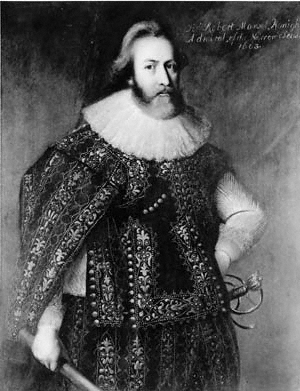Robert Mansell facts for kids
Quick facts for kids
Sir Robert Mansell
|
|
|---|---|

Sir Robert Mansell by unknown artist
|
|
| Born | 1573 Margam, Glamorganshire, Wales |
| Died | 1656 |
| Allegiance | |
| Service/ |
|
| Years of service | 1573–1656 |
| Rank | Vice-Admiral |
| Battles/wars | Anglo-Spanish War |
Sir Robert Mansell (1573–1656) was an important admiral in the English Royal Navy. He was also a Member of Parliament (MP), which means he helped make laws. Most of the places he represented in Parliament were in Wales. Sometimes his name was spelled Mansfield or Maunsell.
| Top - 0-9 A B C D E F G H I J K L M N O P Q R S T U V W X Y Z |
Robert Mansell was born in Wales. His father was Sir Edward Mansel. Robert later moved to Norfolk, England. We don't know much about his very first years in the navy.
He joined a big attack on Cádiz, Spain, in 1596. He was in charge of a ship called HMS Vanguard. Because of his bravery, he was made a knight.
After that, he went on another trip called the Islands Voyage in 1597. This journey was to the Azores islands. He also commanded ships near the Irish coast. In 1602, he helped the Dutch navy defeat six Spanish ships in the Battle of the Narrow Seas.
Because of his success, Mansell became the Vice-Admiral of the Narrow Seas in 1603. The next year, he became the Treasurer of the Navy. This meant he was in charge of the navy's money.
A Famous Disagreement
In 1600, Sir Robert had a big disagreement with a neighbor named Sir John Heydon. This led to a famous fight outside Norwich. Sir John Heydon was badly hurt and lost a hand. This hand is now on display in a museum!
Both Heydon brothers were supporters of the Earl of Essex. They later took part in a rebellion against the Queen. But Mansell stayed loyal to the Queen. He helped arrest those who were involved in the rebellion.
Politics and Business
In 1601, Mansell tried to become a Member of Parliament for Norfolk. He lost that election. However, he was elected as an MP for King's Lynn at the same time. Later, he represented other areas like Carmarthenshire, Glamorgan, and Lostwithiel.
In 1605, he traveled to Spain with the Earl of Nottingham.
Mansell was also involved in court events. In 1606, he performed in a play called 'Hymenaei'. This play was written by Ben Jonson for a royal wedding. He also helped escort Christian IV of Denmark back to Denmark on his ship, the Vanguard.
Sir Robert Mansell was an investor in the Virginia Company in 1609. This company helped set up the first English colonies in America. He was also on their council.
As Treasurer of the Navy, Mansell helped organize a naval show on the River Thames in 1613. This show celebrated the marriage of Princess Elizabeth.
In 1613, he was briefly put in prison. But he was soon released and kept his important jobs. In 1615, he received a special permission to be the only person allowed to make glass in England. He built glass factories in places like Newcastle upon Tyne. He was a pioneer in using sea coal instead of wood to make glass. He also owned glass factories in Lambeth and Woolwich. He even managed the Woolwich Dockyard and the rope-making factory there.
In 1618, Mansell became the Vice-Admiral of England. He stopped being the Treasurer of the Navy. Some people thought this was not a promotion. They believed he was moved to a less powerful job because of concerns about his honesty as treasurer. However, he still seemed to have the King's support. This was true even after his expedition against pirates in Algiers in 1621 did not go well.
In 1620, his name also appeared on the Charter of New England. This meant he was an investor and council member for the Plymouth Company. This company helped settle parts of America. In October 1620, he led warships to the Barbary coast. His goal was to find English people who had been taken as slaves from the coast of South West England.
Family Life
Sir Robert Mansell was married twice. His first wife was Elizabeth Bacon. His second wife was Elizabeth Roper, whom he married in 1617. He did not have any children.
He passed away in 1656.
Honors and Legacy
In 1613, an island in Nunavut, Canada, was named Mansel Island in his honor. It was named by Sir Thomas Button.

